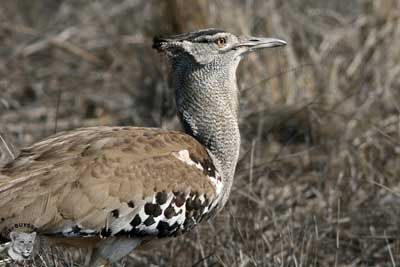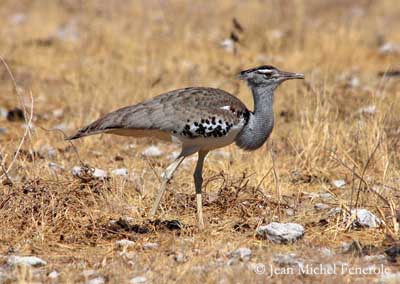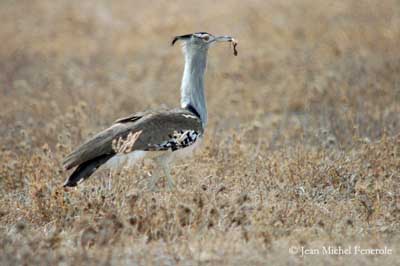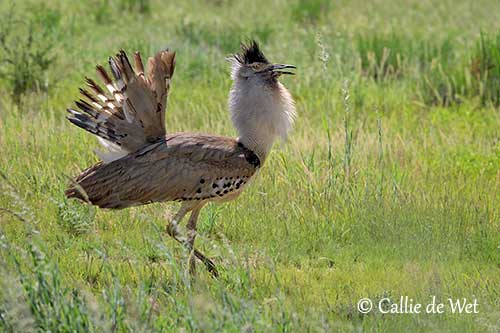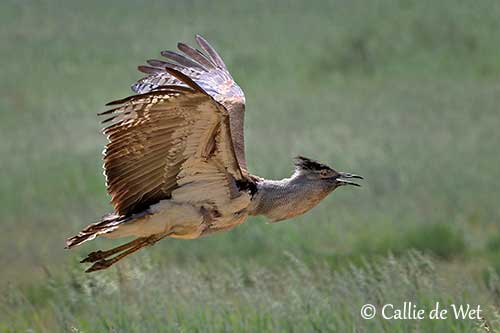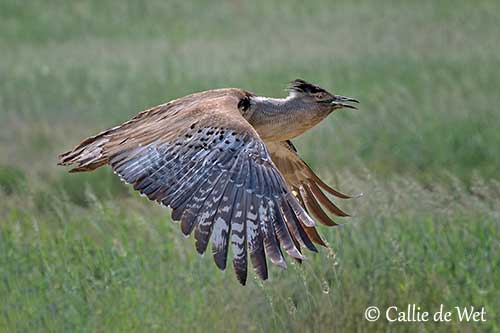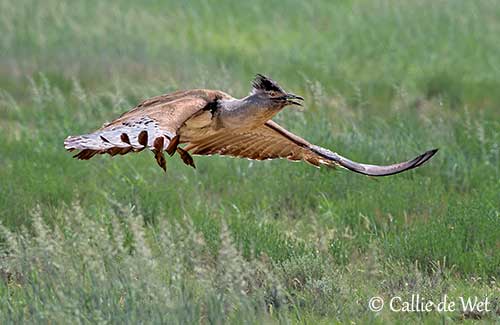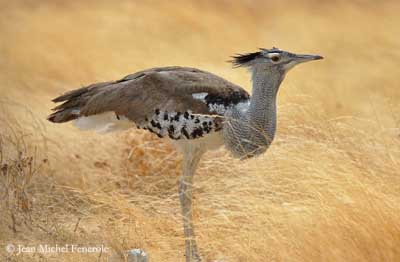
Kori Bustard
Ardeotis kori
Otidiformes Order – Otididae Family
BIOMETRICS:
Length: 128 cm
Wingspan: 122 cm
Weight: M: 19 kg
LONGEVITY: Up to 20 years
DESCRIPTION:
Kori Bustard sizes 120 cm high when head and neck are raised. Male is almost twice larger than female.
Fr: Outarde Kori
All : Riesentrappe
Esp : Avutarda Kori
Ital: Otarda di Kori
Nd: Koritrap
Sd: koritrapp
Photographers :
Didier Buysse
Vision d’Oiseaux
Jean Michel Fenerole
Photos d’Oiseaux
Callie de Wet
GALLERY
Text by Nicole Bouglouan
Sources:
HANDBOOK OF THE BIRDS OF THE WORLD Volume 3 by Josep del Hoyo-Andrew Elliott-Jordi Sargatal - Lynx Edicions - ISBN : 8487334202
BIRDS OF AFRICA SOUTH OF THE SAHARA by Ian Sinclair and Peter Ryan - Princeton University Press Princeton and Oxford - ISBN: 0691118159
Wikipedia (Wikipedia, The Free Encyclopedia)
BirdLife International (BirdLife International)
Welcome to WhoZoo (Jill Foley)

We have two subspecies:
East African subspecies, Ardeotis kori struthiunculus, has a mottled greyish-buff plumage, with dark brown vermiculations.
On the head, the side-crown feathers extend towards nape, forming a black crest. A white stripe crosses the eyes. Chin, throat and neck are whitish, finely streaked with black. Underparts are buff, with dark brown vermiculations.
Tail shows broad greyish-brown and white bands, as the flight feathers which have similar marks. We can see a mottled black and white pattern in shoulder area.
Southern African subspecies, Ardeotis kori kori, appears almost similar, but it is slightly smaller.
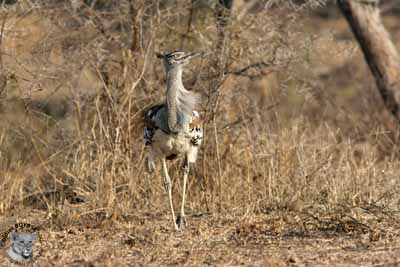

Kori Bustards have long neck, long and strong legs, and long feet with only three fingers. They have not hind toe, indicating a terrestrial life. Legs and feet are pale brown or grey, and are covered with transverse scales.
Bill is short and pale grey. They have excellent eyesight.
Juvenile male has shorter head crest and dark mantle, and is taller than adult female.
Chicks have creamy down, with dark streaks on head, neck, back and flanks. Underparts are whitish.
VOICE: SOUNDS BY XENO-CANTO
During courtship display, Kori Bustard male utters a low-pitched booming sound, a deep “wum-wum-wum-wum-wuuuuum”.
HABITAT:
Kori Bustard lives in open grasslands and lightly wooded savannahs. The two subspecies like areas with short grass, and with a good view of the whole area.
RANGE:
Kori Bustard lives as well in East Africa (Ethiopia, Kenya, and Tanzania) or in South Africa.
BEHAVIOUR:
Kori Bustard doesn’t migrate as much as other birds. It moves only if it needs food or water.
Kori Bustard is the heaviest bird of Africa, and this species is not migratory in the true sense.
Kori Bustard is polygamous. Male often displays for several females. During this display, the male’s neck may inflate to as much as 4 times its size. Tail feathers are stretched to reveal the white under feathers. Tail is fanned upwards and forwards to the neck. Wings may droop down, with primary tips touching the ground. When male displays for a female, it bows towards her with inflated neck and snapping bill, uttering a booming sound. After few seconds of copulation, the male begins another display for other female.
Kori Bustard has a long lifespan, and breeds slowly. It may live alone or in small flocks. It walks slowly with measured strides. It has a majestic walk and it is a remarkably flier.
When they are in a group, Kori Bustards walk in a loose line across the grass, searching for food. They probe with their bill for food, as they slowly walk along. They rarely drink, receiving moisture from their food.
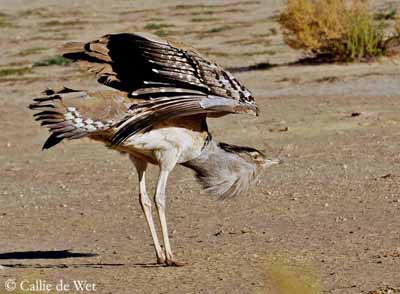
DIET:
Kori Bustard is omnivorous. It feeds on insects (locusts) which are a large part of its diet. Chicks are fed mainly with insects.
It can eat also small mammals, lizards, snakes, but also seeds, berries and plants. Sometimes, Kori bustard eats carrion. It also consumes the gum from acacia tree.
Kori Bustard drinks water by sucking motion, rather than scooping it up as other birds.
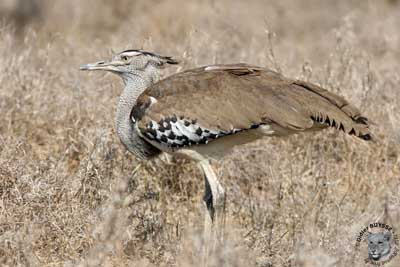
PROTECTION / THREATS / STATUS:
Numbers of Kori Bustards are declining with local extinctions recorded.
Threats are habitat destruction from agriculture and human developments, hunting, and slow reproduction rate.
Kori Bustards breed in captivity since recent years, between good genetic pairing birds.
